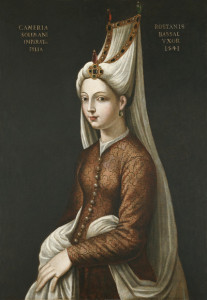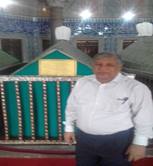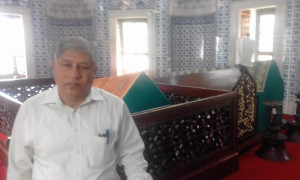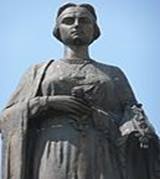Md. Mahtab Uddin, Director General, FIMA
In the Ottoman history, there were a very few women who held name and fame for their love and influence on the husband Sultan as well as a great intriguer. Hurrem Sultan was one of them. Her whole life was very interesting and curious not only to historians and writer, but also to the readers at large. At the very outset of her youth she was captured by a Tartar horde of Crimea whobrought her to Istanbul slave market where she was sold to be destined in the harem of Ottoman Sultan from a slave to Haseki Sultana. She was intelligent, but always favored by fortune. Upon entering the harem, Hurrem quickly learned the royal etiquette and surpassed others to attract the attention of Sultan Suleiman within the first year of his accession to the throne. Sultan Suleiman was not only charmed by her beauty and behavior, he broke the century old harem rules and custom by marrying her. Hurrem gradually elevated her position from a slave to that of ‘the Sultana of the World’ after the title of Sultan Suleiman who assumed the title ‘Sultan of the World’. Sultan Suleiman who happened to spread his rule over a vast region of Asia, Europe and Africa, was also called’ The Magnificent’ and ‘The Law Giver’. Harem life of Ottoamn Sultans was always a curious thing to the people of outside world irrespective of the past and the present. People of Bangladesh have already come to know about many of these features, thanks to the Dipto TV which runs almost one episode of Sultan Suleiman three times a day every week. An episode is telecast at 7.30 PM, which is repeated at 10.00 PM of the same day and 10.00 AM on the following day.
Hurrem Sultan was a peculiar character that people like to love as well as hate. Her astuteness and dexterity pushed her to face up all odd and difficult situations. She was born to an orthodox Priest’s family of Rohatyn (Rohetaneya) of Poland (western part of Ukraine at that time) where a statue of Roxelna was set up to demonstrate her popularity among the Polish. Historians called her by different name i.e. Roxelna, Roxalna, Roxalana, Rose etc. However, her name was Alexandra Liswoska and nickname was Roxalene who was born to an Orthox Priest of Ukraine. At that time the notoriety of the Tatar, who used to raid village after village to loot and plunder the wealth of the people and take young girls as captive to sell them in the ottoman market, rose to a high level. In one occasion, Hurrem and her family fell in the wrath of the Tatar. She lost her parents and other relative and herself was captured by the Tatars whobrought her to Istanbul slave market. But luckily Hurrem was sold to the royal officials who brought her to ottoman palace. At the age of fifteen, Hurrem entered the palace of the Ottoman, she fell in the sight of young Sultan Suleiman who ascended the throne in 1520 and ruled Ottoman Empire for 46 years. At that time, Ottoman Sultan used to choose their wives from among the concubines. Sultan Suleiman had other concubines too, i.e. Gulfum and Mahidiveran, though he admired Hurrem the most because of her cheerful look and playful temperament. He gave her the title of Haseki Hurrem Sultan.
Suleiman loved her so much that he married her by breaking the 200 hundred years old family customs. Before him, the Ottoman Sultan used to take one concubine to be his wife who was allowed to give one child and then leave the palace to avoid blood bath in the royal family. But Hurrem was exceptional as Suleiman. There was an intriguing story about the marriage. In the harem, Hurrem embraced Islam. So when Suleiman chose her to be his main concubine, Hurrem laid a condition that she could not mix with Sultan Suleiman before he married her as she had become a Muslim and Islam would not permit her to stay together before marriage. It is also said that Hurrem did not accept the proposal of Suleiman for marriage unless she had been set free, because she would be considered as the slave even after the marriage and personal property of Sultan. However, Hurrem embraced Islam and learnt the etiquette of the royal family before marriage and gathered profuse knowledge in Turkish grammar. She knew Turkish so well that there was no mistake in the poems composed for Sultan and correspondences made to the dignitaries at home and abroad.
One concubine mother- one son was the principle of Ottoman palace and one mother could give not more than one child. This principle was adopted in the harem to avoid feuds of blood of brothers. On the contrary, Hurrem was allowed to give birth to six children including one daughter. She gave birth to her first child Mehmed after one year she had met Sultan Suleiman.To commemorate this, she was given the title of ‘Haseki Sultan’ which means mother of the Shahjedah. After Mehmed, the children who are born to her were Mihrimah Sultan, Sehzade Abdullah, Selim II, Sehzade Beyazid and Sehzade Chehangir. It was the custom of the royal family that the concubine mother had to go to the province with the son who ruled it. Suleiman’s another wife was Mahidiveran who was also called Gulbahar, left the palace with her son Shehjedah Mostofa. But Hurrem didn’t have to leave the palace though she was the mother of four shehjadahs. She had one daughter named Mihirmah who was married to Rustem Pashah. In the harem, Mahidiveran and mother sultana Ayse Hafsa, a daughter of the Khan of Crimea was her great rival and a fight broke out being instigated by Sultan’s mother when Suleiman was outside the palace to lead a campaign against the Hungarians. But Hurrem managed to save herself from the situation on that occasion. This incident angered Sultan Suleiman who became more tilted towards Hurrem and used to ignore any complaint lodged against her. After the death of mother Sultana Hafsa, Hurrem became unrivaled in the harem and oversaw the palace order and discipline when Sultan was out of the palace.
Though many described Hurrem as a ‘sneaky and seductive’ woman, she had many noble character traits. Sultan admired her blindly because of her intelligence and cheerful laugh. He used to write very sentimental poem with very exotic and aromatic words for her. Hurrem herself also wrote poem for Suleiman. Her language and diction of words in the writings sometimes has stunned the historian. She used to communicate with the dignitaries, counselors and ministers displaying a high level of etiquette and respect. Her discussion with the men of the state used to reveal prowess, wit and authority. Hurrem’s sense of diplomacy was revealed in the letter written to king of Poland on the occasion of his accession to the Polish Throne. Because of her diplomacy, a good relationship with the Polish prevailed during Suleiman’s regime and a statue of Hurrem was set up in her memory in Ruhatynia of Poland where she was born. Sigismund Auguste who ascended the throne of Poland in 1549 maintained alliance with Sultan Suleiman. Hurrem held a special position in the palace, because she learned Turkish language, literature, history, mathematics, and diplomacy proficiently. She acquired huge knowledge on alchemy as she used to request Sultan Suleiman to bring various types of perfumes from abroad when he returned home from an expedition. In a list of perfumes given to Sultan Suleiman during her Hungary expedition was found a name ‘Cologne’ (perfume of Cologne of Germany). From Edrine palace, many tools were discovered which were necessary for use of perfumes and it was believed that those were used by Hurrem.
Sultan Suleiman was a great admirer of Hurrem Sultan and there were rumors in the city at that time that Hurrem was a ‘witch’ that put spell on the Sultan Suleiman, who could not ignore any request of her. This had a fatal consequence as Sultan took it very seriously and punished many citizens of Istanbul for spreading this type of stories. Suleiman used to write poem for his beloved wife under pen name ‘Muhibbi’. In one of his poem he called Hurrem My son, My moon, My Bagdad, My Khorasan, My Istanbul, My Anatolia, My sweet, My Rose, My spring, My daytime, My Woman of the beautiful hair, My Love of the slanted brow etc. However it was said, Sultan Suleiman was so spellbound that he executed his elder son Mostofa, who was the most capable son and very popular to the people who thought he would be the next Sultan after Suleiman, was killed on the charge of sedition. The charge was that Mostofa was conspiring to ascend the throne and with this end in view, instigating the Safavid to lead a war against the Ottoman. Hurrem was also responsible for the slain of two grand vizirs- Ibrahim Pasha and Kara Ahmed. Hurrem and her son-in-law Rustom Pasha, the husband of Mihirmah Sultana successfully turned Suleiman against Shehjada Mostofa saying that he had hand in Safavid rebellion. Mostofa was killed by Suleiman’s order. Ibrahim Pahsah who was the prime minister (the grand vizier) and husband of Shahjedi Hedicha, Sultan’s sister was also killed at the order of Sultan Suleiman. It is said that Hurrem had vitiated the mind of Sultan by citing some incidents. For example, Ibrahim Pashah awarded himself the title of ‘Sultan’ during the campaign against the Persian. Ibrahim Pasha incurred the rage of anger of Sultan for another reason too. Hurrem complained that Ibrahm Pasha executed Iskandar Chelebi on the plea of the commandership issue during the war against Safavid. Because of these, Hurrem was known as a ‘witch’ and master intriguer to many people who believed it by heart.
Hurrem was the first women who lived in Topkapi which was an administrative and educational headquarter. Before that women of the royal family used to live in Old Palace (now Istanbul University). Hurrem complained that her children were missing their father who returned late after finishing the day’s work at Topkapi. Besides, there was an incident that worked for bringing her to Topkapi to get further close to her husband. One day a mysterious fire broke out in Old Palace which prompted Sultan Suleiman to bring her to Topkapi which was not initially constructed as a palace.Later, a gorgeous palace “Dolmabache” was established just beside the other side of the Phosus.
Hurrem Sultan was the owner of immense wealth and property as she was highly paid from royal treasury amounting to 4000 gold coin every day. She was also extravagant to build architectural building in Jerusalem, Adrine, Mecca and Ankara. With the help of the chief architect Mimar Sinan she made a complex (a group of buildings) which was called Haseki Kulliyesi comprising mosque, madrasa, hospital and a soup kitchen. This complex was completely funded by Hurrem Sultan’s own money. She also gave a deed of document (Vakfiye) in which the salaries and duties of the staff, the type of meals to be served, sources of expenses for the maintenance of the building were narrated down. The Hammam which was constructed by Hurrem was also a marvelous one which had two section- one sections for the male and the other section for the women. It was built near the Byzantine church that was partially converted into Haji Sophia Mosque. Hurrem’s Hammam was unique among ottoman hammams. This Hammam is still intact and serves as a luxurious Turkish bath.
Hurrem died in 1558 of severe ulcer in her stomach. Though her beauty was faded to a large extent at the old age, she enjoyed Suleiman’s love at a straight line even after her death. Sultan composed many poems bemoaning the absence of his beloved wife. He introduced ‘imperial monogram’ decorated with ‘exquisite illuminations’ on the occasion of sponsoring Hurrem’s endowment. Not only that he set aside the revenues on the farm and properties that funded the charitable organizations of Hurrem who was entombed in octagonal structure in Sulaymania Complex where the tomb of Sultan Suleiman’s tomb also existed very near. In this tomb was also buried Mihirmah Sultana who ‘inherited her mother’s intelligence, shrewd personality and strong interest in patronage.’
Many writers tried to establish Hurrem as an Ukranian patriot who saved the Ukranian lands from Turkish onslaught.They also tried to establish that the loyalty of the Slavic who contributed a lot to the expansion of ottoman empire by joining the regular army ‘Janissary’ during the reign of Sultan Suleiman should be attributed to Hurrem Sultan. Not only that, she also helped the Christians under Turkish rule. When the rulers of the mainland Europe and the Mediterranean Islands were facing the ripples of Turkish attack, on the East the Ukranians were enjoying the benefit peaceful situation with the Ottomans. These are all possible because of the Ukranian patriot. Off course, there were other Ukranian girls who played a vital role in the harem of Ottomans to whom the beauty of the Ukranian girls were a special attraction. Like Sultan Suleiman, Sultan Selim II and Ibrahim I also married to Ukranian women, one of them was Turhan Sultan, mother of Sultan Mehmed IV. She also had a fame of doing many benevolent works, but she could not attain the level of Hurrem Sultan’s wit and intelligence. Hurrem was always an adventuress who used to exploit the situations and maneuvered her power and position to combat her enemies and favor her well-wishers.
Hurrem Sultan was a self-made woman who excelled in her life as the most assertive and supportive wife of the Sultan. The German historian Hammer wrote in his History of the Ottoman Empire, published in 1834: “[In this mosque] there is a tomb of a Rusynka [Slavic woman from Ukraine] who thanks to her charm and talent managed to rise from the base position of a slave to the lofty level of a legal royal wife; later, when her beauty had long faded, she became the sultan’s closest and only friend who controlled him thanks to her wit and will. The responsibility for the killing of two viziers and for the filicide when Suleiman ordered the execution of his son Mustafa is laid at her feet… This Rusynka ruled her husband, the greatest of Ottoman monarchs, in a way similar to that in which he ruled his dominions.”
To many she was a witch and master manipulator and could twisted the royal power to her interest, even Sultan Suleiman was nothing but a puppet in her hand. Because of her twistasing power, many city dwellers as well as many of the residents of the palace used to believe that she had had a power of magic which she used the way she desired. In 1554, the Austrian ambassador Busbek wrote that he was informed that there were women in the capital who supplied Hurrem Sultan with bones from the skulls of hyenas which were believed to be a very strong aphrodisiac. “But none of them,” he adds, “agreed to sell these bones to me saying they were meant exclusively for Hurrem sultan who, they said, made the sultan continuously attached to her by making love potions and other magic means.”













